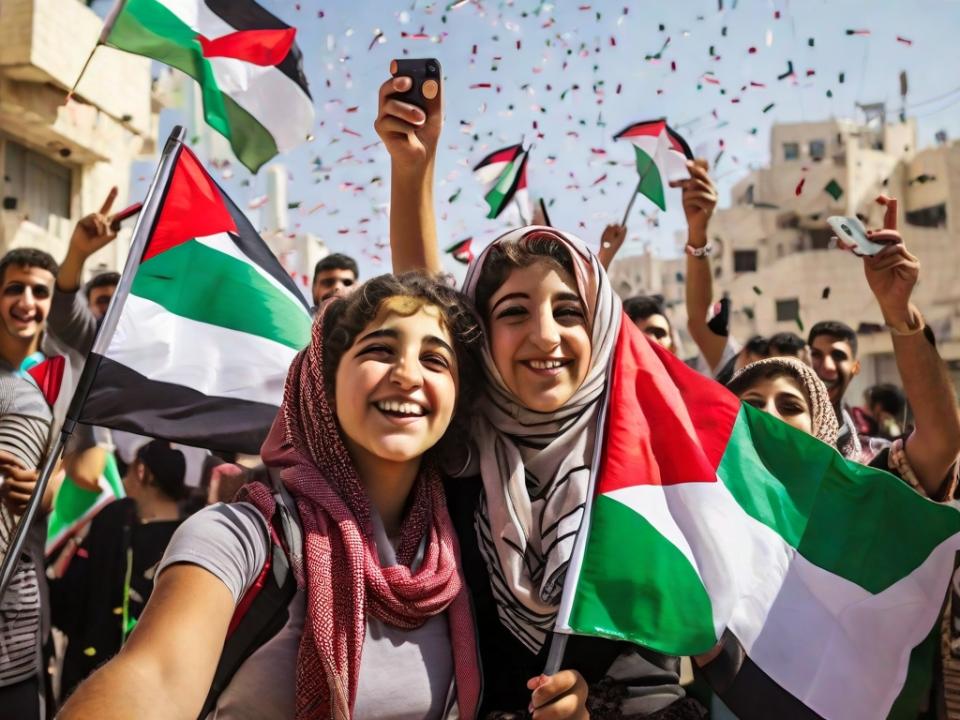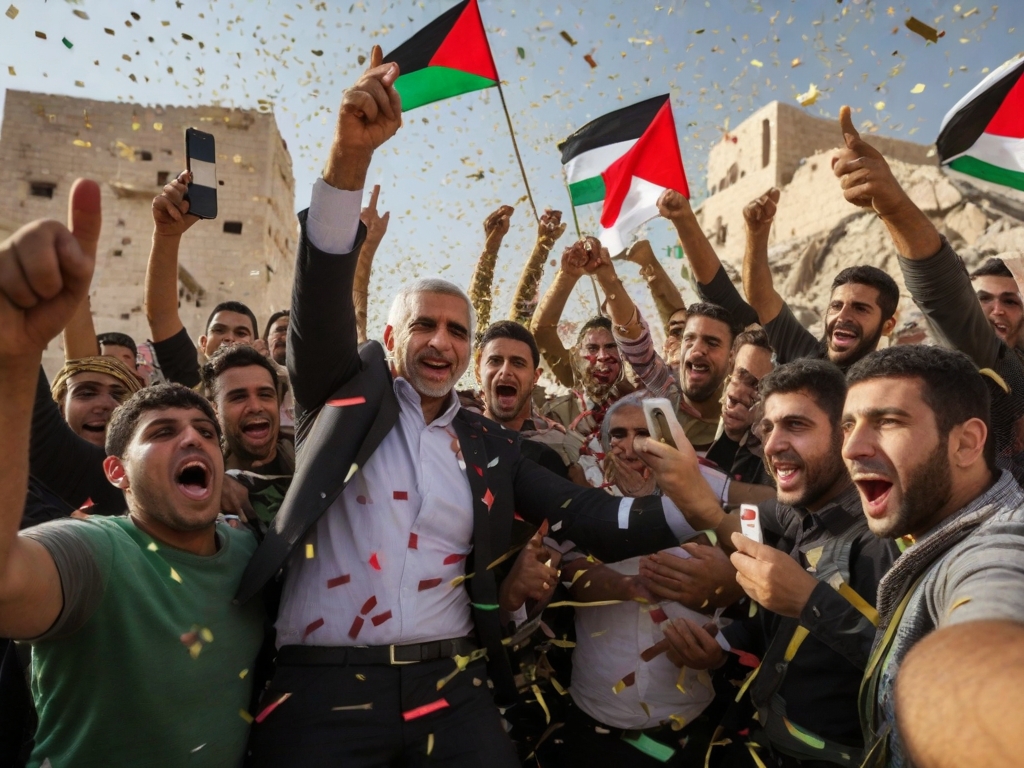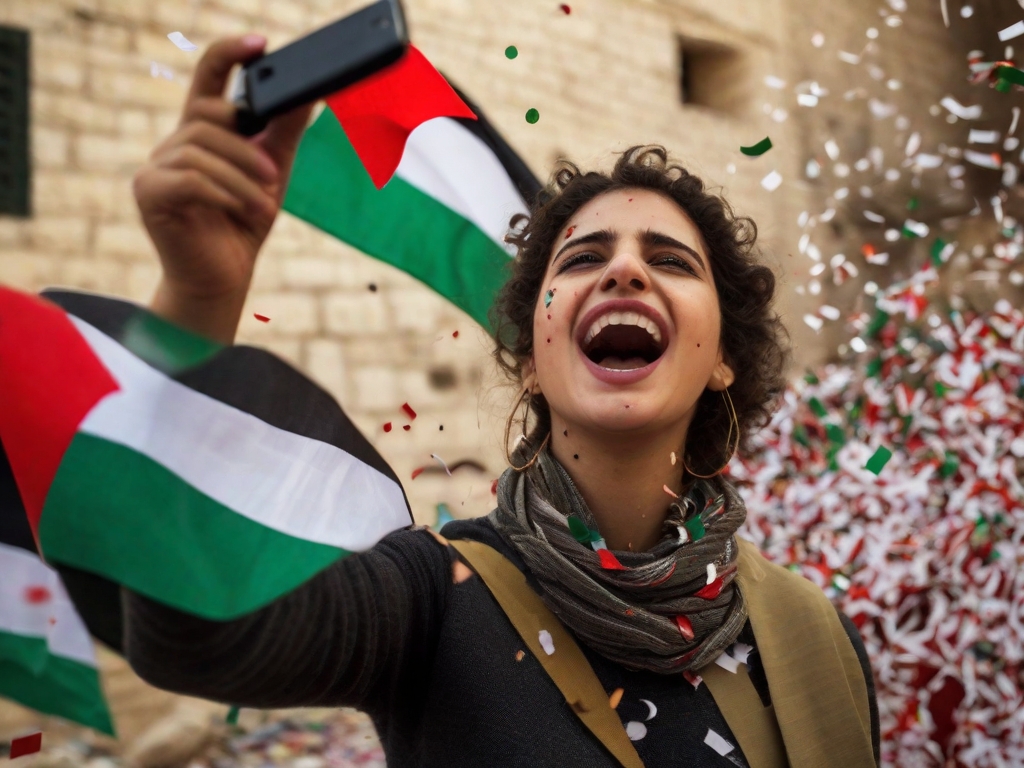
AI-generated artwork "Speculative AI Selfies as a visual spell for liberated futures" by Lineadeluz through the Selfie Institute. Instagram: @lineadeluz
In the digital age, artificial intelligence (AI) is not just transforming industries; it's reshaping the narratives that define our understanding of global conflicts. A striking example of this is a video created with Runway ML – a generative AI app, demonstrating the tool's capability to produce content with a highly polished, almost hyperreal (airbrushed) aesthetic. This technology, while impressive, also raises ethical questions when applied to sensitive political contexts.
A video created with Runway ML exhibits an ingenious yet recognizable style. Its aesthetics often appear highly polished, what I would describe as hyper airbrushed by today’s capacity of the tech. The camera movements allow for delicate zoom-ins. While its adoption in mainstream media is still subject to timid acceptance, it's astonishing to witness how its use can be directly impacted by intention.
In February 2024, the streaming platform Hulu, featured an ad showcasing a speculative and happy scenario for Gaza. The ad begins by leading the viewer into an idyllic vision of Gaza, with palm trees, coastlines, and laughter, resembling a tourism advertisement. It features children at play, people dancing, and the enjoyment of local cuisine, all under the inviting promise of experiencing a culture rich in tradition. However, the tone abruptly changes as the scene transitions, accompanied by a voiceover stating, “This is what Gaza could have been like without Hamas.” The ad then presents a starkly different set of images, depicting civilization dust, weapons, and children in distress, either wandering the streets or armed. The ad ends with the plight, ‘‘Stop Hamas.’’
This 30-second AI-generated spot seeks to deny the longstanding settler colonialism of Israel in Palestine and ongoing genocide of Palestinians into a brief, impactful and misleading message.
It suggests that Hamas, recognised as a terrorist organisation by countries in the Western hemisphere including the United States, Canada, Great Britain, Japan, and the European Union, is responsible for the plight of Palestinians in Gaza. It also implies the ‘need’ for Israeli state intervention unfolded in the form of a genocide. This portrayal simplifies the intricate dynamics of colonialism, aiming to influence the masses.
The Hulu ad employs AI to convey its message, offering a contentious perspective on who is to blame for the hardships faced by the people of Gaza as Israel commits a targeted genocide, a topic that is significantly more nuanced than what is depicted in the advertisement.
Filmmaker and journalist Bisan Owda, who has been documenting the violence happening in Gaza, reposted a picture from journalist Shahin Hazamy, showing not what Gaza could’ve been like but what it was before the decades-long colonial violence and genocide targeting Gaza and the West Bank escalated in October 2023.
The caption added was, “the UN said Gaza needs 70 years to become livable; at least 70% of the infrastructure is destroyed.”
The Instagram images shared by Bisan feature beaches inhabited by people, architectural monuments surrounded by pools, and roads filled with cars and green ecosystems, perhaps in the way the ad wanted to portray as a present that had not existed. In contrast to the images presented by the Hulu ad, these images show the unseen face of Gaza, one that the West isn't used to showing; one that was once a reality, and not generated by AI.
In moments like this, I can only think of the words of the artist and AI researcher K Allado-McDowell about how AI can be used for either harm or healing. The potential of technology for worldbuilding extends far beyond the realms of fiction and entertainment, touching upon the very fabric of our reality and the futures we can imagine and create.
Hamas took control of the Gaza Strip in 2007, following Israel's withdrawal of troops and settlers in 2005, an occupation that began after the 1967 war. Despite the withdrawal, the United Nations and various international entities consider Gaza to still be effectively occupied, a perspective that the US and Israel contest. The Hulu ad employs AI to convey its message, offering a contentious perspective on who is to blame for the hardships faced by the people of Gaza as Israel commits a targeted genocide, a topic that is significantly more nuanced than what is depicted in the advertisement.
Since the escalated attacks on Gaza in October 2023, this has not been the first time that the State of Israel and organised Zionism have used AI to continue the genocide of the indigenous people of Gaza. At the end of 2023, the Israeli government was creating deepfakes to use as evidence that would justify its attacks.
If we go back in time, in Western history, this isn’t the first time where State-sponsored genocides have used the latest technologies of their time to engage in misinformation economies.
In the 20th century, radio emerged as a powerful medium for mass communication in the interwar period and played a pivotal role during World War II. It became the primary tool for disseminating news and propaganda directly to the public and enemy forces, transcending borders and reaching into the heart of enemy territory. William Joyce – an American-born Nazi fascist broadcaster, known also as Lord Haw-Haw for Germany broadcasting to the UK, became infamous for his role in spreading misinformation that supported Nazi sentiments. Although the effectiveness of these broadcasts on morale is debated, he became a significant part of the psychological warfare landscape. Or consider Leni Riefenstahl, the German film director who created "Triumph des Willens," a propaganda documentary about the 1934 Nazi Party Congress in Nuremberg, commissioned by Hitler himself. While the film won awards and was praised for its artistic achievement, it also served as a powerful tool for Nazi propaganda, glorifying Hitler and his party, upholding antisemitism.
If we understand that wars serve to assert colonial and imperial power among nations, in redistributing geopolitical dynamics, it's no surprise that the role of images in Western societies serves to capture the gaze but beyond that, to introduce and reactualize dangerous relationships. The horrific reality they portray, which is misleading, is essential for understanding the full scope of the genocide and for challenging any attempts to deny or downplay its brutality.
This biassed portrayal can skew public perception, making the idea of ethnic cleansing seem like a reasonable or necessary response, legitimising violence by framing it as self-defence or retribution.
Misinformation and disinformation can act as a catalyst for ethnic cleansing by shaping perceptions and attitudes in ways that dehumanise and demonise specific groups. It often involves the fabrication of events or the distortion of facts to portray a group as a threat to societal or national well-being. This biassed portrayal can skew public perception, making the idea of ethnic cleansing seem like a reasonable or necessary response, legitimising violence by framing it as self-defence or retribution.
The implications are grave: genuine suffering and the realities of conflict risk being dismissed as fabrications, undermining efforts for empathy, understanding, and resolution. This vicious cycle of doubt and manipulation distorts public discourse, hampers informed decision-making, and potentially escalates conflicts by fueling division and misunderstanding. The misuse of AI in this context is a stark reminder of the dual-edged nature of technology, capable of both advancing society and deepening its divides.
In this context, the potential for media to be used as a tool for promoting ethnic cleansing highlights the importance of responsible journalism, media literacy, and regulatory frameworks designed to prevent the incitement to violence in its most extreme form: genocide. It underscores the need for media outlets to adhere to ethical standards that prioritise accuracy, fairness and respect for human dignity. Moreover, it calls for the international community, civil society, and individuals to remain vigilant and critical of media content.
The ICJ's provisional decision on January 26 in response to South Africa’s application, mandated several actions from Israel, including efforts to prevent genocide, facilitate humanitarian aid, condemn and penalize genocide incitement, provide monthly compliance reports, and safeguard Palestinian civilians.
However, the court stopped short of meeting South Africa's main plea for halting Israeli airstrikes and establishing a ceasefire in Gaza. Israel strongly denied the genocide claims, criticizing South Africa for allegedly acting as a facade for Hamas. Following the verdict, Israeli Prime Minister Benjamin Netanyahu dismissed the ICJ's ruling, asserting Israel's right to defend itself and comply with international norms, despite ongoing military operations in Gaza.
In February 2024, approximately 1.4 million Palestinians, living in conditions of severe overcrowding in Rafah, an area comparable in size to London's Heathrow Airport, were preparing for the possibility of an attack on the city by Israeli forces. This anticipated assault indeed occurred while people in the United States were tuning in to the yearly Super Bowl event. The genocide continued with human loss. Ceasefire is the solution.

AI-generated artwork that imagines the liberation of Palestine. By Lineadeluz through the Selfie Institute. Instagram: @lineadeluz
Speculative futures
At sunrise, the news unfurled like petals on a spring olive tree - Palestine is free!
"Liberation echoed across the land in a myriad tongues, a universal chant of hope.
A portal to a new reality opened, where the world resonated with the triumphant melody of a liberated Palestine.
In the wake of Palestine’s liberation, the streets transformed into a jubilant tapestry of celebration.
Spontaneous gatherings unfolded, marked by exuberant cheers and the waving of flags.
The jubilation, a harmonious chorus of hope, echoed through the urban landscape.
In the streets, a palpable sense of peace prevailed. The future once promised, was now a reality.
-- Poetry and prompts by Lineadeluz
In digital ecosystems and art making, worldbuilding is not just about envisioning new technologies but also about reimagining societal structures, environmental conditions, and human relationships. Speculative futures challenge the present's limitations by asking "what if" and exploring potential outcomes, both utopian and dystopian. This practice intersects with science fiction, speculative design, and futurism.
What do we dream for the collective liberation of Gaza and the indigenous peoples of their land? We dream and invoke a world where children and all people are free from oppression and genocide, we dream of reparations and coalitional work that will effectively change life circumstances and keep cultures and their lifeworlds respected and safe. In this context, it’s worth looking at grassroots creative practices carving paths for other futures, practices from digital, feminist killjoys (using Sara Ahmed’s term), who are activating powerful magic.
We invoke images that burn the fences of patriarchal violence, of the myth of existential risk and the contours of white supremacy.
Digital artist, designer and organiser Lineadeluz has created speculative selfies for ”liberated futures” through the Selfie Institute. The Institute’s mission is to deepen understanding of digital self-representation, stimulating exchanges to enrich collaborative learning around the Self(ie), with the vision of creating critical self-expression narratives, challenging algorithmic power.
For Lineadeluz, the selfie is positioned as a practice of visual decolonization, especially for historically excluded communities, enabling them to craft and sustain memory and identity on their own terms. It challenges traditional media's restrictive narratives, offering a space for diverse expressions of identity and community. The power in these images lies not only in the decolonization but further re-indigenization of the Gaza liberation, a path for land back.
The images portray Gazans in moments of joy and unity, as they come together to celebrate liberation. People of all ages, smiling and taking selfies, create a vibrant tapestry of community spirit against the backdrop of their bustling surroundings. Amid these scenes of celebration, individuals and groups wave flags with fervour and pride, adding a powerful visual symbol of their identity and aspirations.
The flags, held high, flutter against the sky or amidst the crowds, their colours bold and bright, embodying the collective dream of freedom. The atmosphere is charged with the energy of chants, as Gazans document and share these pivotal moments. Joyous selfies, a narrative of resilience, and shared vision for a future filled with dignity and independence.
Intention isn't just about willpower or sheer determination but involves aligning oneself with the energy or the field of intention, the power of intention which operates on a more spiritual, interconnected level. I first came across the work of Edgar Fabian Frias, an artist, brujx and therapist a few years ago, and in their work they mentioned the power art and images have in building new neural pathways for neural manifestations to take place. When I see these images, I see joy, hope and love transcending our digital screens, freedom from the systemic violence of colonial occupation.
We invoke images that burn the fences of patriarchal violence, of the myth of existential risk and the contours of white supremacy.
Speaking up in this context becomes an act of communal courage, inspiring others to join in resistance and fostering a united front against injustices. Speaking up is a call to action, urging our many communities to mobilise, educate, and engage in sustained efforts to dismantle oppressive structures. In doing so, speaking up in solidarity embodies the commitment to not only recognize but actively fight against the structural violence embedded within society, aiming to create a more equitable and just world for all. This act of solidarity is a testament to the power of collective action and the importance of supporting transcontinental movements for liberation and justice.

AI-generated artwork that imagines the liberation of Palestine. By Lineadeluz through the Selfie Institute. Instagram: @lineadeluz
If you’re a US American, please call your representatives, the world must heal. Divest from corporations supporting and funding ongoing genocide, the world must heal.
I’d emphasise again that the only solution is immediate and permanent ceasefire.
From the river to the sea, Palestine will be free.























Add new comment